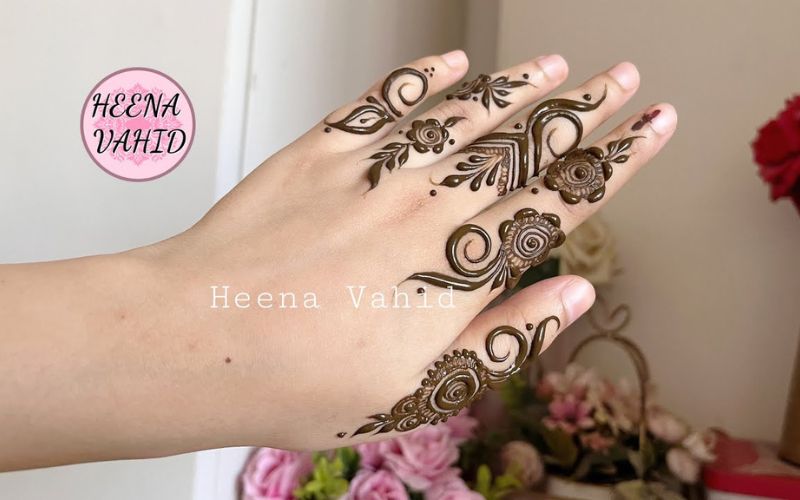Mehendi, also known as henna, has been an integral part of cultural and religious ceremonies in various parts of the world, particularly in South Asia, the Middle East, and North Africa. It is a form of body art that uses a paste derived from the leaves of the henna plant to create intricate patterns on the skin. These patterns, often seen on the hands and feet, symbolize joy, beauty, and cultural heritage. While there are many complex and elaborate designs, simple mehendi designs have their own charm and significance. In this article, we will explore the beauty and elegance of simple mehendi designs, their cultural importance, and tips for creating your own.
The Cultural Significance of Mehendi
Mehendi holds a special place in various cultures, particularly in Indian, Pakistani, and Middle Eastern traditions. It is often applied during weddings, festivals, and other significant celebrations. The application of mehendi is not just about aesthetics; it is deeply rooted in cultural and spiritual beliefs.
- Weddings: In Indian and Pakistani weddings, mehendi is a crucial pre-wedding ritual. The bride’s hands and feet are adorned with intricate designs, symbolizing beauty, love, and prosperity. It is believed that the darker the mehendi, the stronger the love between the bride and groom.
- Festivals: Festivals like Eid, Diwali, and Karva Chauth also see women and girls decorating their hands with mehendi. It is a way to celebrate and embrace cultural heritage and traditions.
- Rituals and Ceremonies: Mehendi is used in various other ceremonies, such as baby showers, religious ceremonies, and family gatherings. It signifies joy and auspiciousness, marking the importance of the occasion.
The Charm of Simple Mehendi Designs
While elaborate mehendi designs are undoubtedly stunning, simple mehendi designs have their own appeal. They are easier to create, require less time, and still look beautiful and elegant. Here are some reasons why simple mehendi designs are popular:
- Ease of Application: Simple designs are easier to apply, making them perfect for beginners or those who want to try their hand at mehendi art.
- Versatility: Simple designs can be worn on any occasion, whether it’s a casual get-together, a small family function, or a festive celebration.
- Minimalistic Beauty: The minimalistic nature of simple mehendi designs exudes elegance and grace. Sometimes, less is more, and these designs prove that simplicity can be just as stunning as complexity.
- Quick to Apply: For those who are short on time, simple mehendi designs are a great option. They can be applied quickly without compromising on the beauty of the art.
Popular Simple Mehendi Design Patterns
There are various patterns and motifs commonly used in simple mehendi designs. Here are a few popular ones:
- Floral Patterns: Flowers are a staple in mehendi designs. Simple floral patterns with leaves and vines are easy to create and look beautiful on the hands and feet.
- Geometric Shapes: Geometric shapes like circles, squares, and triangles can be used to create stunning designs. These shapes can be arranged in various ways to form unique patterns.
- Paisleys: Paisleys are another popular motif in mehendi designs. Simple paisleys can be drawn in a variety of sizes and combined with dots and lines to create an elegant design.
- Dots and Lines: Using dots and lines, you can create intricate-looking designs that are actually quite simple. These elements can be used to fill spaces and add detail to the design.
- Mandala Designs: Mandalas are circular designs that represent the universe in Hindu and Buddhist symbolism. Simple mandalas with basic patterns can look incredibly elegant.
Tips for Creating Simple Mehendi Designs
Creating simple mehendi designs can be a fun and rewarding experience. Here are some tips to help you get started:
- Choose the Right Cone: Ensure you have a good quality mehendi cone that allows for smooth application. The tip of the cone should be fine enough to create detailed patterns.
- Practice Basic Shapes: Before attempting a full design, practice drawing basic shapes like circles, lines, and paisleys on a piece of paper. This will help you get comfortable with the cone and the flow of the mehendi paste.
- Keep it Simple: Don’t overcomplicate the design. Start with basic patterns and gradually add more elements if you feel confident. Remember, simplicity is key.
- Use Reference Images: Look for simple mehendi designs online or in mehendi books for inspiration. Having a reference image can guide you in creating a balanced and beautiful design.
- Practice Patience: Mehendi application requires a steady hand and patience. Take your time and enjoy the process. Rushing can lead to mistakes and uneven designs.
- Clean Hands: Ensure your hands are clean and dry before applying mehendi. This will help the mehendi adhere better to the skin.
Step-by-Step Guide to a Simple Mehendi Design
Here is a step-by-step guide to creating a simple and elegant floral mehendi design on the back of the hand:
- Prepare Your Mehendi Cone: Make sure your mehendi cone is ready for use. If you are using a pre-made cone, cut the tip to your desired thickness. If you are making your cone, fill it with fresh mehendi paste and secure it tightly.
- Start with the Center Flower: Begin by drawing a small flower in the center of the back of the hand. Create a simple five-petal flower by drawing small teardrop shapes arranged in a circular pattern.
- Add Leaves and Vines: Extend the design by adding leaves and vines around the central flower. Draw small leaves on either side of the vines to add detail and fill the space.
- Create a Border: Draw a simple border around the design to frame it. You can use dots, lines, or small flowers to create a border that complements the central design.
- Add Dots and Lines: Fill in any empty spaces with dots and lines. This will add depth and intricacy to the design without making it too complicated.
- Finish with a Mandala: If you want to add a bit more detail, you can create a small mandala at the wrist. Draw a series of concentric circles with simple patterns inside each ring.
- Let it Dry: Allow the mehendi to dry completely. This usually takes a few hours. Once dry, gently scrape off the dried paste and avoid washing the area for at least 12 hours to ensure the color develops fully.
Caring for Your Mehendi Design
To ensure your mehendi design lasts longer and appears darker, follow these care tips:
- Avoid Water: Try to keep the design dry for at least 12 hours after application. Water can hinder the development of the color.
- Apply Lemon-Sugar Solution: Once the mehendi starts to dry, you can apply a mixture of lemon juice and sugar to the design. This helps in darkening the mehendi and making it last longer.
- Keep it Warm: Warmth helps in the darkening of mehendi. You can gently warm your hands over a stove or use a hairdryer on a low setting to keep the area warm.
- Moisturize: After the mehendi has fully developed, apply natural oils like coconut oil or mustard oil to moisturize the skin and enhance the color.
- Avoid Harsh Soaps: Harsh soaps and detergents can cause the mehendi to fade quickly. Use mild soaps and avoid excessive scrubbing of the design.
Conclusion
Simple mehendi designs are a beautiful way to celebrate cultural heritage and add elegance to any occasion. Their minimalistic nature and ease of application make them accessible to everyone, whether you are a beginner or a seasoned mehendi artist. By practicing basic patterns and following the tips provided, you can create stunning designs that reflect your personal style and creativity. Embrace the art of mehendi and enjoy the beauty and tradition it brings to your life.





